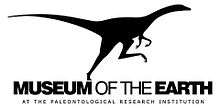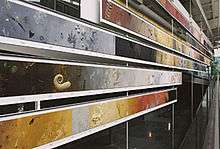Museum of the Earth
 | |
 Location of the Museum of the Earth in New York | |
| Established | 2003 |
|---|---|
| Location | 1259 Trumansburg Road, Ithaca, New York |
| Coordinates | 42°27′59″N 76°32′10″W / 42.466306°N 76.536203°W |
| Visitors | 30,000 |
| Director | Dr. Warren D. Allmon |
| Architect | Weiss/Manfredi |
| Website | museumoftheearth.org |
| Ithaca Discovery Trail | |
The Museum of the Earth is a natural history museum located in Ithaca, New York. The museum was created in 2003 as part of the Paleontological Research Institution (PRI), which studies the history of the Earth and its life. Both PRI and the Museum of the Earth are formally affiliated with Cornell University.[1][2] The Museum of the Earth is home to earth-science exhibits and science-related art displays with a focus on the concurrent evolution of the Earth and life.
History
In the spring of 1994, the PRI Board of Directors approved the proceedings for the initial planning of building a museum to operate in accordance with PRI. With state financial support of $2 million, PRI began the design process for the Museum of the Earth in January 1999. The museum opened to the public in 2003. The museum project took almost ten years to complete and cost more than $11 million.[3]
The Museum occupies an 18,000-square-foot (1,700m²) addition to the PRI complex on Ithaca's West Hill. The building was designed by New York architectural firm Weiss/Manfredi. The design for the museum won the American Institute of Architects's regional awards or "Excellence in Design" and "Honor Award for Architecture" in 2004.[4]
Exhibits
The Museum of the Earth has both permanent and traveling exhibits. Recent examples of the latter include 'Maize', 'Whales', and 'Science on the Half Shell', with 'Sanctuary Reef' planned to open in late June 2012. The permanent exhibits include The North American Right Whale #2030; Rock of Ages, Sands of Time; and A Journey Through Time.
The North American Right Whale #2030:
In 2003, North American Right Whale #2030," a whale skeleton, was installed in the museum lobby. By 2004, a permanent exhibit about the whale was put on view, funded by a grant from the Nelson B. Delavan Foundation. The whale was killed when she was caught in fishing cable. Rescuers attempted to free her, but she fought them off, swimming hundreds of miles before dying.[5] The exhibit includes a short film by David Brown featuring footage of the unsuccessful attempts to rescue #2030 from the fishing gear that ultimately killed her.
The specimen was obtained by the PRI in 1999, when Director Dr. Warren D. Allmon expressed interest in acquiring the skeleton after he was notified by the National Marine Fisheries Service that a 44-foot Northern Right Whale had been spotted dead off the coast of Cape May, New Jersey. PRI was informed that they could take the skeleton if they assisted with cleaning the whale carcass. Three days later, the skeleton arrived at PRI.[6]
PRI’s whale was mounted on a steel armature in a greenhouse on-site. The museum building was left open on the northeast end so that the whale could be brought through for installation. In November 2002, a crane carried the pieces into the building and lifted them to the ceiling, where they were attached to a beam built specifically for the purpose.[7]
Rock of Ages Sands of Time

This exhibit is a series of 544 mural paintings by artist Barbara Page. The mural functions as a visual record of an immense period of time—an eon, five hundred and fifty million years—between the origin of visible macroscopic life on the planet and the present. Each of the tiles represents the passage of one million years. Fossil fauna and flora make their appearance in chronological order against a background reflecting geologic events. All of the organisms are depicted at true scale.[8] A book contains reproductions of each painting and describes their scientific context in detail.[9]
A Journey Through Time
This exhibit leads visitors through billions of years, from the Big Bang to the present day, with an additional focus on the future as shaped by human effects and dependence on Earth. A Journey Through Time explores scientifically technical areas such as geologic processes, evolution, biodiversity as well as the cultural contexts of such scientific understanding. The exhibits include three subsections devoted respectively to the Devonian of central New York State; the Triassic-Jurassic of the Connecticut, Newark, and Hudson Valleys; and the Quaternary Ice Age. The exhibit contains four audio-visual object theaters featuring short films narrated by geologist and Cornell President Emeritus Frank H.T. Rhodes.
Activities include a video illustrating the formation of the solar system and planet Earth, the Fossil Preparation Lab, and a garden that mimics the landscape of the northeastern United States during the Ice Age, with tundra vegetation, polished gravel, and large boulders (glacial erratics).[10] The exhibit also features a selection of fossils from PRI’s collection and the Hyde Park Mastodon.
The Hyde Park Mastodon
The Hyde Park mastodon was discovered when Larry Lozier hired an excavator to deepen the pond in the backyard of his home in suburban Hyde Park, New York in 1999. After the excavation, the family noticed some unusual-looking logs that on further investigation turned out to be the bones of a mastodon.[11]
In June 2000, staff from PRI along with volunteers from several organizations and universities began draining the pond and discovered more mastodon bones.[12] The excavation took approximately 6 weeks and more than 95% of the bones were discovered, including both of the tusks, the skull, and the major limb bones. The mastodon is an American mastodon (Mammut americanum), and was most likely an older male that weighed an estimated 10,000—15,000 pounds. After assembly, The Hyde Park Mastodon exhibit was put on display at the Museum of the Earth in September 2003.[11]
During the excavation, PRI excavated 22,000 pounds of sediment, or matrix, from the site. PRI turned to volunteers to help sort through the rest of the matrix in what is known as the Mastodon Matrix Project.[13]
Educational Programs
The Museum of the Earth aims for a broad audience, with features intended to appeal to both children and adults, scientists and non-scientists. As part of its association with Cornell University, the museum also offers resources for educators.[14]
Cecil A. Physis
Cecil A. Physis is the Museum of the Earth’s official mascot. He is a Coelophysis, a small, bipedal carnivorous dinosaur. A statue of him, created by Brazilian sculptor Yure Berkley Lima de Alenca, can be seen near the museum’s entrance. Dinosaur fossils in the Central New York region are rare, so he has been coined “New York’s only known dinosaur.” The museum also includes three Coelophysis footprints preserved in slabs of rock.[15]
Discovery Trail
The Museum of the Earth is part of Ithaca’s Discovery Trail, which features seven area educational institutions: Cayuga Nature Center, Cornell Lab of Ornithology, Cornell Plantations, History Center in Tompkins County, Johnson Museum of Art, Sciencenter, and Tompkins County Public Library. The Discovery Trail was established in 1999.[16]
References
- ↑ "About". Paleontological Research Institution. Retrieved 2012-03-23.
- ↑ Broad, William J. "Academic Rift Is Healed, and Paleontology Gains". 3 May 2005. New York Times. Retrieved 10 January 2013.
- ↑ "PRI History". Paleontological Research Institution. Retrieved 2012-03-23.
- ↑ "Awards". Weiss/Manfredi. Retrieved 2012-03-23.
- ↑ James, Rebecca (1999-10-25). "Bone By Bone". Syracuse Post Standard. External link in
|newspaper=(help) - ↑ Gold, Martha (1999-10-25). "PRI Welcomes Whale Remains". Ithaca Journal. External link in
|newspaper=(help) - ↑ LaMattina, Diana (2002-11-18). "Volunteers Work Their Fingers to the Bone". Ithaca Journal. External link in
|newspaper=(help) - ↑ "Rock of Ages, Sands of Time". Paleontological Research Institution.
- ↑ Barbara Page and Warren Allmon (2001). Rock of Ages, Sands of Time. Chicago: University of Chicago Press. ISBN 978-0226644790.
- ↑ "A Journey Through Time". Paleontological Research Institution. Retrieved 3/9/2012. Check date values in:
|access-date=(help) - 1 2 Rothbaum, Rebecca (2000-08-23). "Mastodon Find Hailed". Poughkeepsie Journal. External link in
|newspaper=(help) - ↑ "Research/Excavation". Paleontological Research Institution. Retrieved 3/9/2012. Check date values in:
|access-date=(help) - ↑ Parry, Wynne. "Mastodon Hair". Live Science. Retrieved 2011-05-22.
- ↑ "Outreach". Paleontological Research Institution. Retrieved 2012-03-30.
- ↑ Allmon, Warren D. (2007). The First 75 Years: A History of the Paleontological Research Institution. Ithaca: Paleontological Research Institution. p. 95.
- ↑ "Discovery Trail Organizations". Discovery Trail.